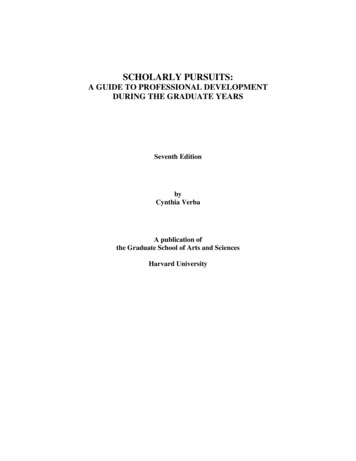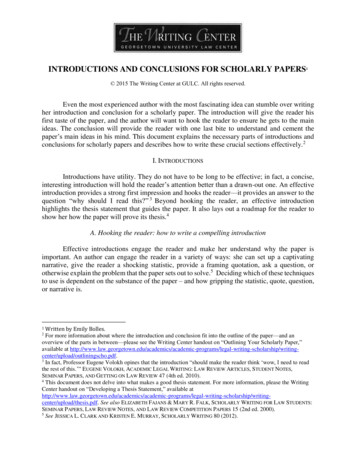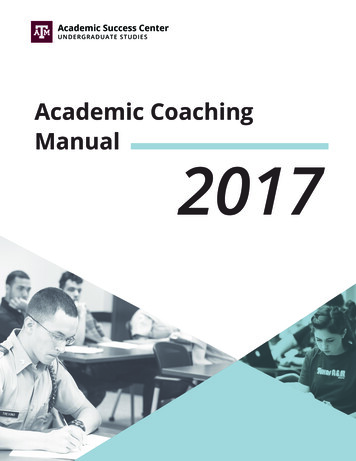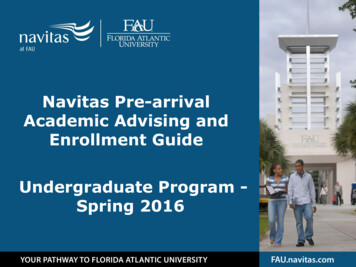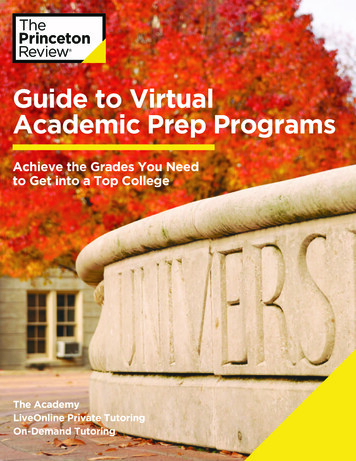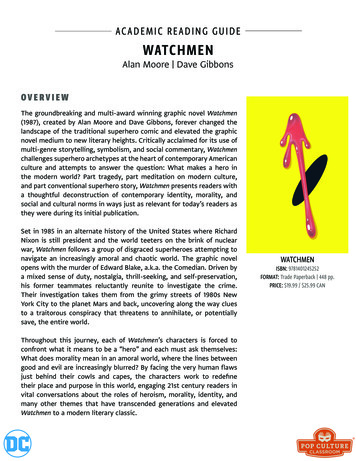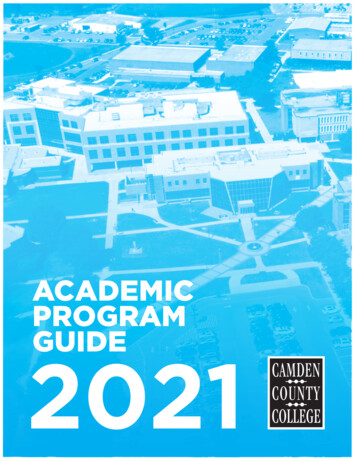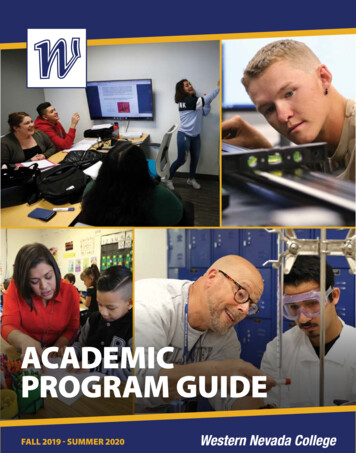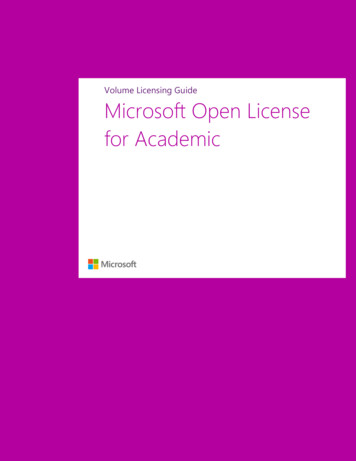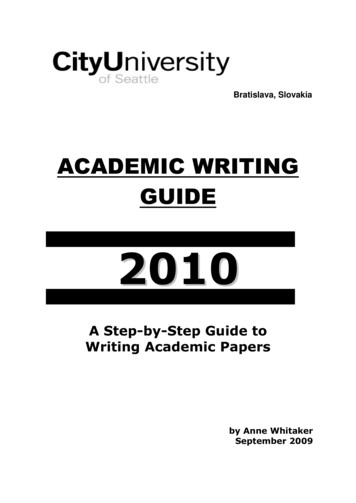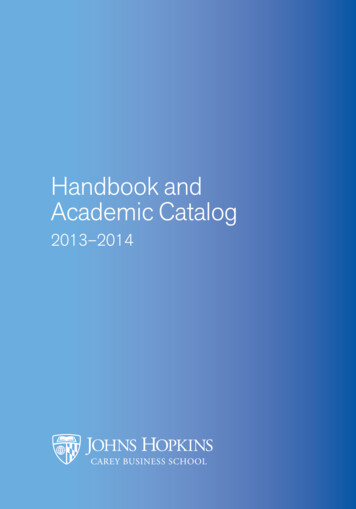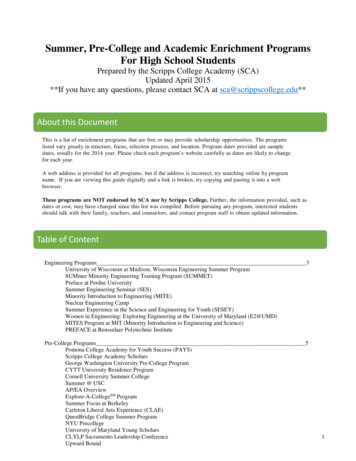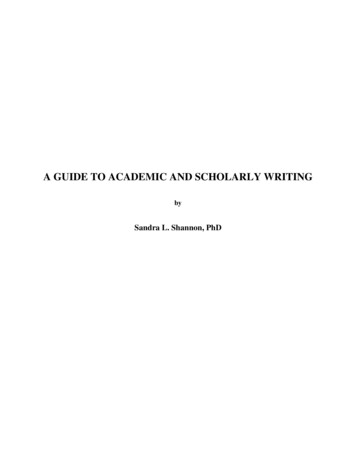
Transcription
A GUIDE TO ACADEMIC AND SCHOLARLY WRITINGbySandra L. Shannon, PhD
Copyright 2011 Baldwin Book PublishingAll rights reserved. Printed in the United States of America. Original material herein may not bereproduced, distributed, or stored in any form without the permission of the copyright holder,except as specified in the U.S. Copyright Act of 1976.Published by Baldwin Book Publishing, Oveido, FLISBN 978-1-61817-004-0 (pdf)ISBN 978-1-61817-005-7 (mobi)ISBN 978-1-61817-006-4 (epub)
Table of ContentsChapter 1: Introduction . 1Chapter 2: The Two Types of Writing . 2The Forms of Academic and Scholarly Writing . 2Language: Levels of Formality . 3Chapter 3: Structure: Planning the Paper . 4Topic Selection . 4Research . 4Organization. 4Basic Structure of Academic Writing . 4Thesis Statement . 5Introduction . 6Background Information . 7Points of Discussion. 7Conclusion . 8Chapter 4: Revision. 9Chapter 5: Coherence. 11Organizational Structure . 11Paragraph Unity . 11Sentence Cohesion . 12Transition Words and Phrases . 12Parallelism (Parallel Construction) . 12Repetition . 13Enumeration . 14Introductory Words or Phrases . 14Letters or Numbers . 14Common Problems with Cohesion . 14Tense . 14Tone . 14Voice . 15Person. 15Number . 15Chapter 6: Precision and Clarity in Language . 17Biased Language . 17Gender Bias. 17Other Forms of Bias . 17Slang and Shortened Word Forms . 18Coined Words and Expressions . 18Imprecise Words . 18Wordiness . 20Word Choices in Discussing Results . 20iii
Chapter 7: Quotations . 21Accuracy . 21Introduction and Discussion . 21Grammatical Context . 21Shortened Quotations . 22Shortening . 22Using Ellipses . 22Block or Indented Quotations . 23Emphasis . 23Citation of Sources. 23Chapter 8: Editing . 24Conventions of Writing. 24Spelling . 24Hyphenation . 25Abbreviations and Acronyms . 25Apostrophes . 26Possession . 26Omission . 27Chapter 9: Sentence Sense . 28Complete Sentences . 28Fragments . 28Run-On Sentences. 29Voice . 29Subject–Verb Agreement . 30Misplaced Modifiers, Dangling Modifiers, and Split Infinitives. 32Faulty Parallelism . 32Chapter 10: Punctuation. 34Commas . 34Separating Items in a Series . 34Connecting Independent Clauses . 34Setting Off Introductory Phrases and Clauses . 35Setting Off Introductory Words . 35Setting Off Nonrestrictive Phrases and Clauses . 35Setting Off Nonrestrictive Appositives . 36Setting Off Contrasting Elements . 36Setting Off the Year in Exact Dates . 36Setting Off Items in an Address . 36Semicolons . 37Independent Clauses . 37Items in a Series . 37Colons . 38With Explications or Amplifications . 38With Lists . 38With Quotations . 38iv
With Time . 39With Scriptural References . 39End Punctuation . 39Dashes and Parentheses . 39Dashes . 40Parentheses. 40Brackets. 40Quotation Marks . 41Direct Quotations . 41Titles of Minor Works . 41Translations of Foreign Words and Phrases . 41Coined Words and Words Used in Unusual Ways . 42Punctuation with Quotation Marks . 42Double or Single Quotation Marks . 43Ellipsis. 43Chapter 11: Capitalization . 44When to Capitalize. 44When Not to Capitalize. 46Chapter 12: Formatting . 47Chapter 13: Plagiarism and Citation . 48Citing Sources . 48Using Endnotes and Footnotes. 48Chapter 14: Final Words . 49References . 50v
Chapter 1: IntroductionEffective writing skills are essential not only for attaining professional credentials but also foradvancing in one’s career. Although sometimes treated synonymously, academic and scholarlywriting do have some variations in their purposes and characteristics. Understanding thedistinctions between academic and scholarly writing and employing them appropriately may bethe difference between a stellar professional career and one of continual angst resulting from thepublish-or-perish paradigm.The purpose of this guide is twofold: to aid graduate students in understanding the distinctions between academic andscholarly writing and to provide professionals with a resource for maintaining and improving their skills incrafting scholarly discourse.To accomplish these objectives, information concerning both academic and scholarly writing ispresented. Specific problems graduate students and professionals may encounter in craftingpublishable works are also identified and explained. The tips and techniques presented have beengleaned from numerous sources and represent the most common problems and pitfalls inproducing well-written papers, articles, monographs, and books.1
Chapter 2: The Two Types of WritingAcademic and scholarly writing bear striking resemblances to each other. However, subtledifferences exist between the two. Where academic writing may be defined broadly as anywriting completed to fulfill university or college requirements, scholarly writing is produced toinform a specialized audience of other scholars in a particular field. Scholarly writing is craftedby one professional for other professionals (“Definition of Academic Writing,” 2011). Graduatestudents may wish to think of scholarly writing as a subset of academic writing.The purpose of academic writing is to present information about a specific subject precisely andobjectively (Nordquist, 2011). Academic writing in college and graduate school is usually gearedtoward students demonstrating their mastery of content and the analytical and writing processesrequisite for entry into their professions. Generally, authors generate either expository orargumentative prose to complete the requirements.The purpose of scholarly writing is the advancement of knowledge within a specific field. Morethan a demonstration of the author’s expertise, scholarly writing is produced to add to the bodyof knowledge, extending, challenging, or expanding what is known or believed within the field.Thus, while all scholarly writing is academic writing, not all academic writing is scholarlywriting.The Forms of Academic and Scholarly WritingThe forms of writing authors may produce are varied. In general, academic writing is found inessays, course papers, research papers, book reports, translations, theses, dissertations, books,articles, technical reports, critiques, and abstracts. Scholarly writing is limited to scholarly books,treatises, technical reports, legal documents, journal articles, and monographs. However,according to Stanton (2008), the accepted forms for scholarly writing are expanding. Althoughmonograph and journal articles are the preferred forms of scholarly writing—for some, the onlyappropriate forms—other forms, such as collections of articles or essays, translations of primarytexts, trade books, articles for more general audiences, essays, critical reviews, tradepublications, and even textbooks, have begun to be recognized as legitimate vehicles for authorsto demonstrate their content knowledge and to contribute to the body of knowledge within theirspecific fields.Although the forms of scholarly and academic writing are converging, in part due to theadvances in digital publishing, the purpose and intended audience of scholastic writing continueto demark the subtle differences between the two types (Stanton, 2008). Graduate students,doctoral candidates, and individuals in the beginning stages of their professional careers maybenefit from choosing to present their views in more traditional formats. As in most arenas, onemust follow the rules until one achieves a certain level of acceptance and authority. At that point,if one breaks the rules, others consider it creativity and genius rather than immaturity, naïveté, orignorance.2
Language: Levels of FormalityGraduate students and professionals must be aware of the level of formality required in theworks they produce. Authors employ one of three basic levels of language: formal, semiformal,or informal (Driscoll & Brizee, 2011). The level for any work should be based on the targetaudience and the purpose of the work.Informal language is rarely used in academic or scholarly writing. This level is moreconversational in style, often does not follow conventional rules of grammar and mechanics, andmay include the use of slang and colloquialisms. Personal letters, conversations, socialnetworking entries, and dialogue in popular forms of literature are usually written in informalEnglish.In academic writing, authors may use either semiformal or formal language. The choice shouldbe based on audience and purpose. Authors use semiformal language in business letters toindividuals well known to them, in professional writing intended for a general audience such astrade publications, and in personal essays. Conventional rules of grammar and mechanics apply;however, the tone is more personal. Authors refer to themselves in the first person (i.e., I, we)and to their readers in second person (i.e., you). Judicious use of contractions, shorter sentences,and more reader-friendly vocabulary mark this level.Formal language is generally used in academic and scholarly writing. Conventional rules ofgrammar and mechanics apply; however, the tone is more serious. Authors use third person inreferring to themselves and to their readers. Contractions are not used. Sentences may be morecomplex in structure. Vocabulary is more formal and precise. Abbreviations and acronyms areused judiciously. Because the audience is often other people in the same profession, authors mayuse more technical terms. People within the profession know and understand these terms andexpect them to be used. However, if the audience is more general, including people not familiarwith the vocabulary of the profession, the use of technical terms should be kept to a minimum.Authors should also consider defining the technical terms that are used.3
Chapter 3: Structure: Planning the PaperStructuring a paper or an article is not a one-time event but an ongoing process. It is notcomplete until the final draft is ready for submission. Planning includes topic selection, research,and basic organization and structure.Topic SelectionIn graduate classes, students may have the general topics of their papers selected for them.Within those generalities, however, each student must choose a specific area of focus.Professionals may select from the topics of interest noted in the journals within their fields as thestarting points for articles. Authors may also engage in brainstorming, free writing, and mindmapping to generate potential topics. Another option is to choose to transform one’s dissertationor course papers into scholarly articles for submission to those journals.ResearchAfter choosing the general topic, authors must engage in research to narrow the topic and gatheradditional information for support material. The intricacies of research are beyond the scope ofthis paper. However, authors should conduct a thorough literature review as a minimum. Doingso will allow them to see what others have written on the topic and to determine the gaps in theliterature.Research should also be ongoing, done intermittently throughout the writing process. As authorscraft their thesis statements and develop their points of discussion, they may need additionalmaterial to flesh out their works. Authors should also keep abreast of the most recentpublications concerning their topics to ensure their articles are timely.OrganizationAuthors may use either informal or formal techniques to organize their material into a cohesivewhole. Once the thesis statement is developed (see next section), the author may use the informaltechniques of brainstorming, free writing, or mind mapping to identify primary and secondarypoints of discussion and evidentiary support. Authors may also generate lists or questions toguide the organization of their material.A more formal approach is the classic outline. One of the benefits of an outline is its parallelstructure (i.e., if there is an A, there must be a B). The outline should contain the main ideas, thekey points under those ideas, and the specific details of those key points. With well-developedoutlines, authors can see insufficiencies in information immediately and adjust accordingly.Basic Structure of Academic WritingAcademic writing is usually expository or argumentative and is structured similarly to the fiveparagraph theme learned in high school: introduction, body, and conclusion. At the college orgraduate level, authors use a more refined version of this structure: introduction (including thesis statement),4
background,points of discussion, andconclusion.In argumentative writing, authors may refine the structure further: introduction,background,evidentiary support,counter arguments, andconclusion.Thesis StatementThe thesis statement is the controlling idea of the paper. More than a topic, which may be only aword or phrase, the thesis states the specific point of view of the author in relation to the topicand identifies the focus of the paper for the reader. Thesis statements may be the most difficultpart of academic writing, but the stronger the thesis statement, the easier the rest of the paper isto write. The following three examples show the difference between weak and strong thesisstatements for a paper on the Emancipation Proclamation.Weak:Lincoln issued the Emancipation Proclamation to free the slaves.Better:Lincoln issued the Emancipation Proclamation to free the slaves in theSouth, hoping they would fight with the North to secure the Union.Best:Although slaves in the South were freed under the provisions of theEmancipation Proclamation, Lincoln’s purpose in issuing the proclamationwas not to abolish slavery but to end the war more quickly.In each successive example, the focus of the paper becomes narrower as the thesis statementbecomes more specific. The first thesis identifies only one general fact about the topic. Thesecond gives a more specific point of view but is still general compared with the third thesis. Thelast example tells the reader specifically what to expect in the paper.In the early stages of writing, authors should be flexible in terms of their theses. Writers usuallyrefine their thesis statements as they continue to research their topics and write their drafts.Doing so is normal. Authors may find they have either too much or too little information tosupport their original positions and must shift the foci of their papers.In traditional American academic writing, the thesis statement is usually placed in theintroductory paragraph or section of a paper. Having the thesis at or near the beginning allowsthe reader to identify the author’s specific intent and position immediately. Readers may thenfollow the supporting points and arguments more easily. Depending on the purpose, however,and the intrinsic interest the target audience may have for the topic, authors may place thesisstatements anywhere in their papers that makes sense and grabs the attention of their readers,even at the end of their papers as part of their conclusions.5
Occasionally, authors may use implied thesis statements. Although still well developed, impliedthesis statements are never stated. Readers deduce the theses from the content of the papers.Using implied thesis statements may be risky, however, because what is clear to authors may notbe clear to readers.Some forms of writing do not require thesis statements at all (not even implied theses). Theseforms include factual reports, many types of business writing, and narrative or descriptive pieces.IntroductionIt’s been said that, if an author creates a strong beginning and a strong ending, what happens inthe middle is not important. Although that statement is not entirely true, especially in academicand scholarly writing, a strong beginning is still important in well-written papers.Introductions are the hooks authors create to capture the attention of their readers. Throughintroductions, authors must not only identify the content of their papers but also engage thereaders sufficiently so that they continue reading. To do so, authors should avoid weakintroductions, illustrated in the following three examples:This paper is about the Emancipation Proclamation.Lincoln had several reasons for issuing the Emancipation Proclamation.The Emancipation Proclamation was issued in 1863 to free the slaves in theConfederacy.Although these statements do tell readers something about the paper, they generate littleenthusiasm for continuing to read.Writers may choose from several techniques and variations of these techniques to build interestgrabbing introductions. For each of the four techniques listed, an example of an introduction forthe paper on the Emancipation Proclamation is given: Statistics or unusual facts: In 1863, only 50,000 of the 4 million slaves in the UnitedStates were freed when Lincoln issued the Emancipation Proclamation. Theremainder of the 3.1 million slaves in the South did not gain their freedom until theareas in which they lived were under the control of Union armies. However, not untilthe passage of the Thirteenth Amendment were all slaves released from bondage(Emancipation Proclamation, 2011). An anecdote, brief story, or illustration: On a recent trip to Washington, D.C., myfamily and I saw the Emancipation Proclamation during a rare exhibit of thedocument at the National Archives. Hearing a parent explain that Lincoln freed theslaves with this proclamation, I realized the extent to which the intent and actualeffect of this document are misunderstood by most Americans. A quotation: “My paramount object in this struggle is to save the Union, and is noteither to save or to destroy slavery,” stated Lincoln in his letter of August 22, 1862, to6
Horace Greeley, editor of the New York Tribune, in response to one of Greeley’seditorials. Yet many Americans erroneously believe that the intent of theEmancipation Proclamation, announced in September 1862 and officially issuedJanuary 1, 1863, was to free the slaves (Emancipation Proclamation, 2008). A question: As we celebrate the 150th anniversary of the Civil War, we are drawnto the most notable events during that conflict, not the least of which was the issuingof the Emancipation Proclamation. But what was Lincoln’s real intent in issuing thisfamous decree? The end of slavery or the preservation of the Union?Finding the right hook may be difficult, but a perfect introduction is not necessary during thedrafting stages of the writing process. Authors may begin with rough introductions to use asguides. As they work with the information, organizing it and rewriting it, they may discover theperfect introductions for their papers.Background InformationTo ensure readers have sufficient information about the topic to follow the arguments presented,authors provide background information about the topic. This basic information forms thecontext for the main points of the paper. Authors may use possible questions readers may have asguides for choosing the information to present. In the case of the Emancipation Proclamationpaper, readers may have these questions concerning the context of the proclamation: What hadbeen happening up to that point, not only in the war effort but also on the home front? What wasthe average person expecting? What was the political climate?The amount of background will vary with the topic and the length of the paper. In short papers,the background may be contained
The forms of writing authors may are varied. In general, academic writing is produce found in essays, course papers, research papers, book reports, translations, theses, dissertations, , books articles, technical reports, critiques, and abstracts. Scholarly writing
